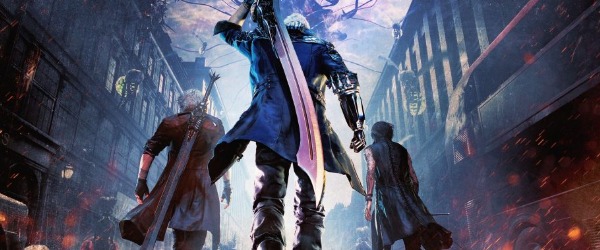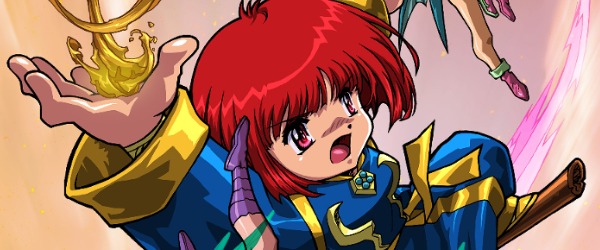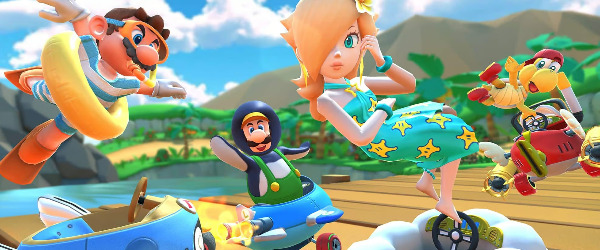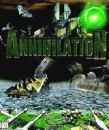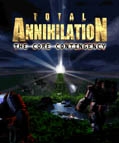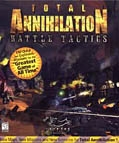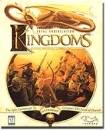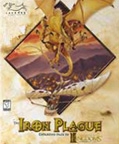
Forgotten Gems #5: Total Annihilation - Article
by Taneli Palola , posted on 10 April 2018 / 5,986 ViewsIn the mid-to-late 90s the real-time strategy genre was dominated by two companies. Westwood Studios, which had pushed the genre into the mainstream with its Command & Conquer games, and Blizzard, which came along a bit later to provide an alternative with WarCraft and StarCraft. Most other developers had little to no success in trying to gain a foothold in the genre at the time, although naturally there were a handful of exceptions.
One of the developers trying to make its mark in the genre around this time went by the name of Cavedog Entertainment. Founded in 1996 by the former LucasArts designer Ron Gilbert, the studio's first project was an ambitious RTS title headed by the then relatively unknown game designer Chris Taylor. This project would soon become known as Total Annihilation.
Total Annihilation – War Across Galaxies
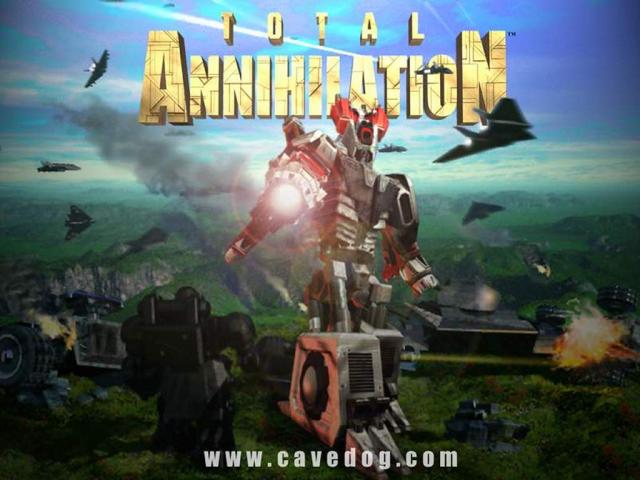
In the latter half of the 1990s the RTS genre was at the peak of its popularity, with countless developers trying their hand at them. Initially Total Annihilation was just one of many similar looking games in development at the time, but as more and more was revealed of the title it became clear that it was going to be something special. When it was released in September of 1997 it proved to be just that.
Total Annihilation's narrative focuses on a conflict of galactic scale, which at the start of the game has already lasted for over four millenia, between the AI controlled machines of the Core and the human rebels of the Arm who use clones to supply their army with soldiers. Ultimately, though, the narrative is largely there to facilitate the gameplay, and for the most part remains on the sidelines with very little presence outside of the mission briefings.
In contrast to the relatively simple and shallow story, the gameplay in Total Annihilation was, especially for its time, impressively deep. There's the usual base building and resource gathering (metal and energy in this case) that one comes to expect in games like this. The two warring sides are fairly similar in terms of gameplay at first glance, but their differences become more apparent the more you play the game.
Arm in general is the faster of the two sides, while Core's units can on average take more punishment. In addition, there are differences in the two sides' strengths and weaknesses, Core being stronger at sea while Arm has vastly more nimble units both in the air and on land. The player can thus plan his or her strategy around these differences, and with the unit cap eventually going up to 5000 per side the battles can escalate into genuinely gargantuan proportions.
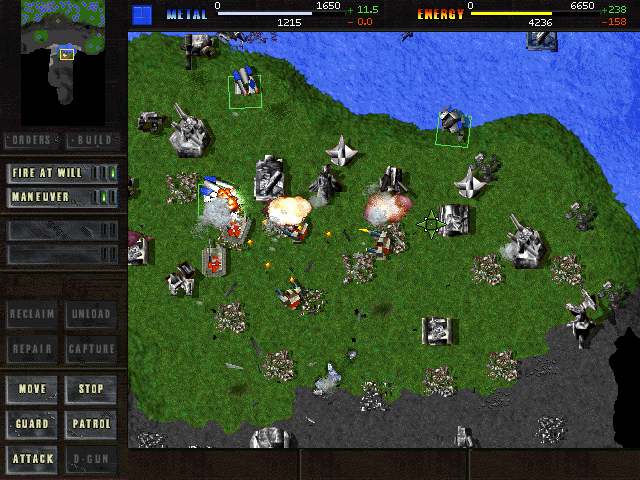
Total Annihilation also featured alternating terrain height values that could impact the gameplay. The player can make use of the height differences in the environment to block enemy fire, increase his own units' range by placing them on higher ground, and create choke points. The maps also have their own wind, tide and gravity values, changing the battle conditions from map to map.
However, the gameplay itself does have a slight twist on the usual resource gathering – base building – unit construction triangle. The resources in the game are limitless, and accumulate on a constant steady rate that increases based on the number of corresponding energy/metal gathering buildings the player has constructed. In addition, the various units and buildings construct things at different speeds, with the commander for example being several times faster in this respect compared to the basic construction vehicles.
This means that units that are faster at building structures will also deplete resources at a much faster rate, and if the pace of resource usage exceeds the rate at which they are required your resources will begin to deplete. If they run out, not only will the construction of new units slow down to a crawl, but buildings that require energy will shut down as well. This gives the gameplay another element the player needs to balance.
The score for Total Annihilation was composed by Jeremy Soule, who is today likely best known for his work on The Elder Scrolls series. The music in-game has been programmed to change dynamically, reacting to events in real-time. As such, battles are accompanied by louder, bombastic tracks, while construction and other calmer moments are surrounded by a more ambient style of music.
Upon release Total Annihilation received hugely positive reviews, with many at the time saying it was the best game of the year and calling it the peak of the genre. Unfortunately, I can't say how well the title sold at the time, as there don't seem to be any sales figures available anywhere. However, the fact that it not only received two expansion packs a year after release, but also a sequel titled Total Annihilation: Kingdoms, would suggest that it was quite successful in terms of commercial performance.
Why Was Total Annihilation Forgotten?
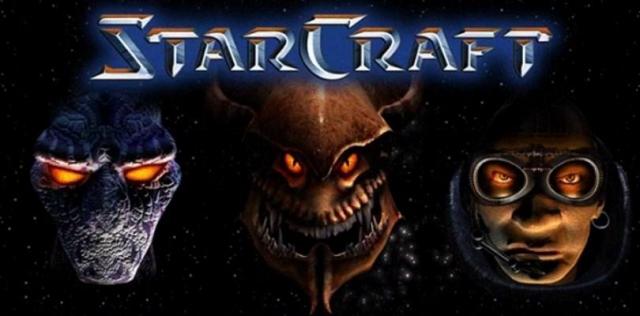
As is often the case with games featured in this series, there were a number of different reasons why the name Total Annihilation isn't brought up in conversations about the best RTS games of all time nearly as much as others like Command & Conquer, WarCraft, StarCraft, and Age of Empires. Various factors ultimately came into play that relegated Total Annihilation to relative obsurity.
Perhaps the most obvious reason was the simple fact that at the time there was more competition within the genre than ever before. It was very difficult for any title not part of a big franchise to remain popular for extended periods of time. Total Annihilation not only had to contend with expansions to older titles like C&C: Red Alert and WarCraft II, but also had to fight for attention against a number of hyped upcoming releases like StarCraft and Age of Empires.
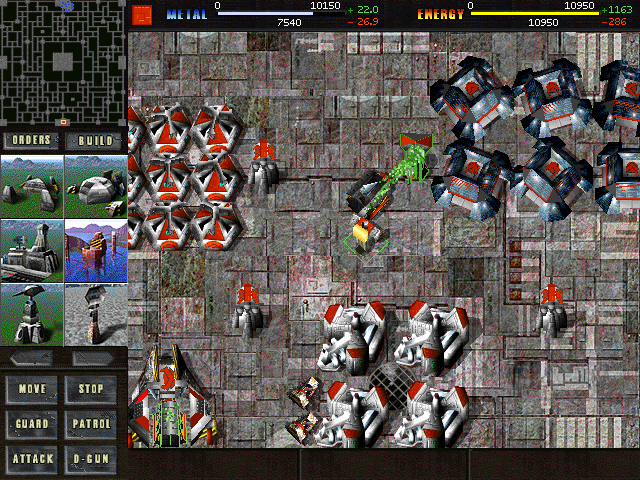
However, even more significant was the very short time that Total Annihilation was able to spend in the limelight. Unlike those other series I mentioned, which quite literally have had up to 25 years to build their fanbase and fame, Total Annihilation as a name in the video game industry essentially disappeared in less than three.
Much of this was due to Cavedog Entertainment going out of business in 2000, after which the rights to the Total Annihilation name first fell to Infogrames, and were then later bought by Wargaming, neither of which has shown any real interest in reviving the franchise outside of re-releasing the original on modern PC market places with little to no fanfare or marketing.
What Makes Total Annihilation Still Worth Remembering?
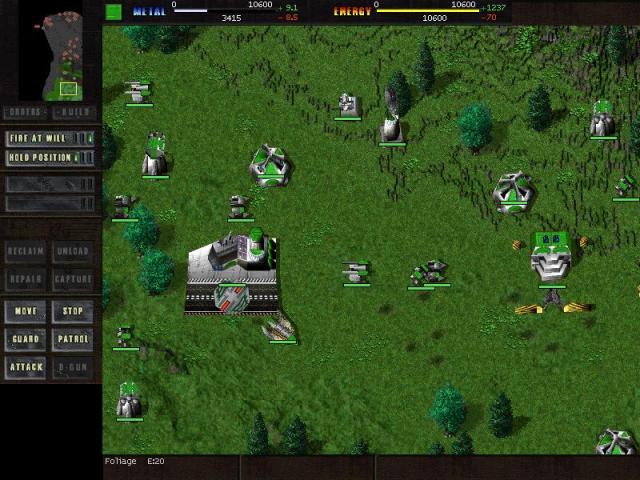
Besides being one of the best RTS titles released during what many would consider the genre's heyday, Total Annihilation still holds up today remarkably well. The gameplay has depth that, while not quite on par with the genre's more recent top releases, pushes it above most of its peers from the late 90s.
The visuals are naturally dated by today's standards, but they still serve their purpose without diminishing the overall experience. The environments have a high degree of interactivity not seen in other games of the era, and the design of the various units gives them an overall unique look that isn't affected by the game's somewhat aged graphical quality.
In addition, Total Annihilation contains one of the best original scores ever composed for a video game. Jeremy Soule created one of his best works to this day very early in a career that includes games like The Elder Scrolls V and Guild Wars. The only real negative to the score is its relatively short length, consisting of just 17 songs in total, while most famous video game scores can sometimes contain over 100 tracks. Regardless, it's still a wonderful score filled with amazing pieces of music.
Finally, Total Annihilation deserves to be remembered for the influence it had on the genre as a whole. From introducing new gameplay elements to the genre, to pushing the limits of what RTS games could achieve in regards to things like number of units available at one time, and paving the way for titles like Supreme Commander, Planetary Annihilation, and many others.
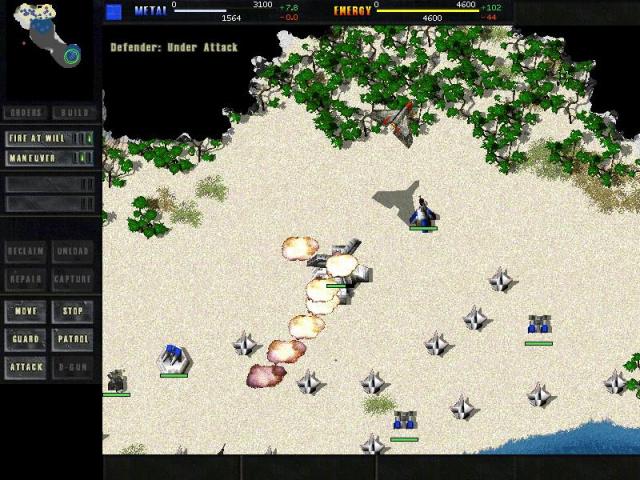
For anyone interested in trying out Total Annihilation, the title is available on both Steam and Gog.com at very low prices, and includes both expansion packs. To add to that, fans of the title have spent the last 20 years creating countless mods, with new units and factions that provide a near endless amount of additional content for players. If you're even slightly interested in playing Total Annihilation, I can highly recommend doing so as it is more than worth the low asking price, especially if you're a fan of the genre and have yet to experience this particular classic.
More Articles
Even by todays standards, this game sits as one of the best RTS games ever made. Everything about this game is amazing. I remember trying to get DLC for it back in Dail Up days for extra Units and Buildings. Perfect example of a 1 hit wonder.
I loved that game growing up. I have no idea what happend to the game or it's box but I spent so much time playing it. I played a lot of RTS games as a kid but that's one that I would love to go back to.
Biggest problem for me was that it wasnt so much a basebuild resource gather but more like a zerg rush RTS. Where the AI opponent always rushed with T1 units. Same problem with Supreme Commander.
Ah I had this game! A good RTS game. Not on the level of Red Alert, Warcraft, and Starcraft, but about top of the line game for the next level down.









